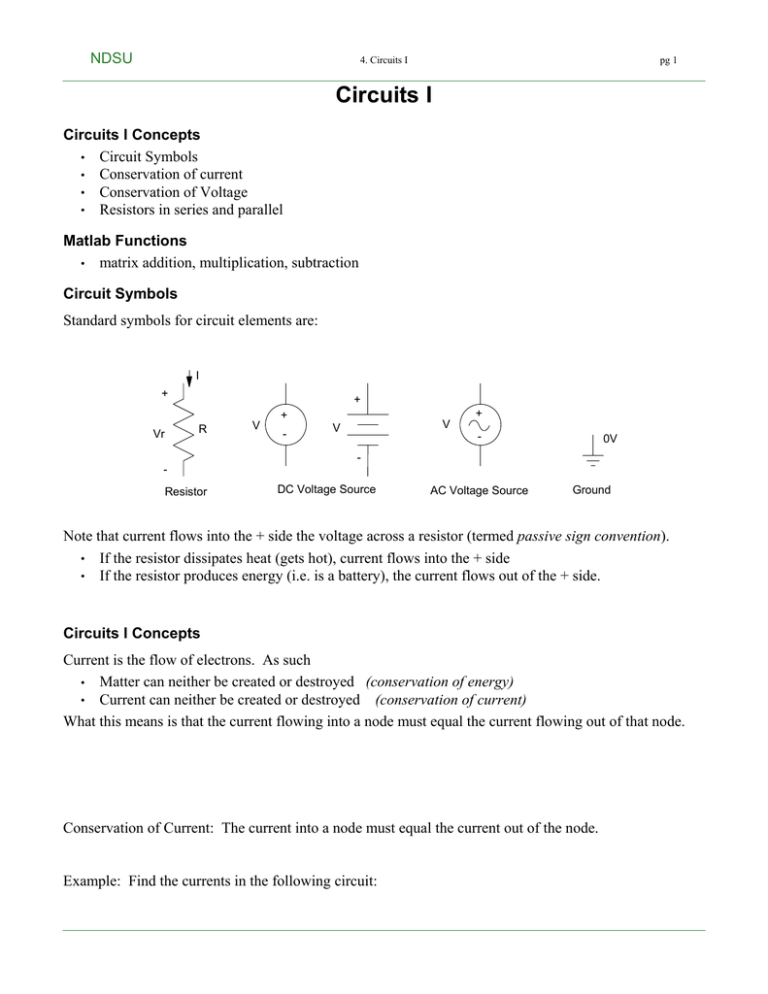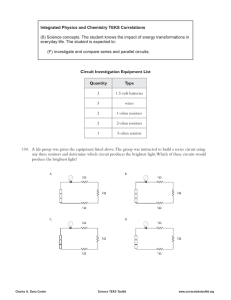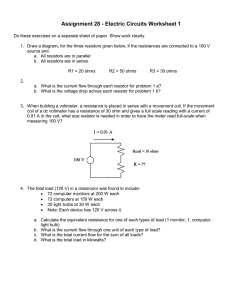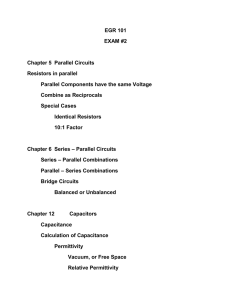Circuits I - Bison Academy
advertisement

NDSU 4. Circuits I pg 1 Circuits I Circuits I Concepts Circuit Symbols Conservation of current Conservation of Voltage Resistors in series and parallel Matlab Functions matrix addition, multiplication, subtraction Circuit Symbols Standard symbols for circuit elements are: I + + R Vr V + + - V V - 0V Resistor DC Voltage Source AC Voltage Source Ground Note that current flows into the + side the voltage across a resistor (termed passive sign convention). If the resistor dissipates heat (gets hot), current flows into the + side If the resistor produces energy (i.e. is a battery), the current flows out of the + side. Circuits I Concepts Current is the flow of electrons. As such Matter can neither be created or destroyed (conservation of energy) Current can neither be created or destroyed (conservation of current) What this means is that the current flowing into a node must equal the current flowing out of that node. Conservation of Current: The current into a node must equal the current out of the node. Example: Find the currents in the following circuit: NDSU 4. Circuits I pg 2 60A 80A 100A Ia Ic Ib From conservation of current Current In = Current Out 100A = Ia + 80A Ia = 20A 80A = Ic + 60A Ic = 20A 60A = Id Ib = Ic + Id = 80A Id NDSU 4. Circuits I pg 3 Conservation of Voltage: The net voltage around any loop must add to zero Example: Find the unknown voltages. V1 + - + V4 Ib V3 V2 - + + Id - + 55V - + 80V + Ia - + 60V 45V Ic - - Solution: Find a loop where you know all but one voltage, such as Ia. Summing the voltages around the loop with a minus sign if you hit the - input first Ia: -80 + V2 + 60 = 0 V2 = 20V Ic: -60 + V3 + 45 = 0 V3 = 15V Id: -45 - V4 + 55 = 0 V4 = 10V Ib: V1 + V4 - V3 - V2 = 0 V1 = 25V NDSU 4. Circuits I pg 4 Simplifying Resistor Circuits: The fundamental equations for Circuits is V=IR 12V + Iin 200 Iout Resistors in Series: Resistors in series add. Example 1: R1 + 12V - R2 I + V3 R3 - The current for resistors in series is the same for all three resistors (current in = current out) The voltage across all three are: V = IR 1 + IR 2 + IR 3 V = I ⋅ (R 1 + R 2 + R 3 ) V = I ⋅ R net Example 2: Find the total resistance if R1 = 100, R2 = 200, R3 = 300 Ohms,. Solition: The total resistance is the sum of the resistors R net = 100 + 200 + 300 R net = 600Ω NDSU 4. Circuits I pg 5 Voltage Division: The voltage across R3 is V 3 = IR 3 R V 3 = ⎛⎝ R 1 +R 32 +R 3 ⎞⎠ 12V The voltage across a resistor for resistors in series is The resistance you’re measuring across ⎞ V R = ⎛⎝ The total resistance ⎠ ⋅The input voltage Resistors in Parallel add as the inverse of the sum of the inverses: Example Ia Vin I1 I2 + - R1 R2 Current In = Current Out Ia = I1 + I2 + I3 From V = IR V V V I a = ⎛⎝ Rin1 ⎞⎠ + ⎛⎝ Rin2 ⎞⎠ + ⎛⎝ Rin3 ⎞⎠ I a = ⎛⎝ R11 + R12 + R13 ⎞⎠ V in V in = I a ⎛⎝ R11 + R12 + R13 ⎞⎠ −1 V in = I a R net Example: Find the net resistance if R1 = 100, R2 = 200, R3 = 300 1 1 1 ⎞ R net = ⎛⎝ 100 + 200 + 300 ⎠ R net = 54.54Ω −1 I3 R3 NDSU 4. Circuits I pg 6 Example: Determine the resistance of the following network from A to B 200 100 300 A 100 300 200 100 200 300 B Solution: The three resistors to the right are in series. They add 200 100 A 100 900 200 100 200 B 900 in parallel with 200 is 1 1 ⎞ 900 200 = ⎛⎝ 900 + 200 ⎠ −1 = 163.63Ω 200 100 A 163.63 100 100 B 200, 163, and 200 in series is 563.63 Ohms 563.63 Ohms in parallel with 100 Ohms is 84.93 Ohms 200 NDSU 4. Circuits I pg 7 100 A 84.83 100 B (100, 84.93, 100) in series is 284.83 Ohms ans: The total resistanec is 284.83 Ohms NDSU 4. Circuits I pg 8 Homework: 1) Use conservation of current to find the unknown currents Ia 15 75 Ie Ib 22 Id Ic 100 28 27 16 If 12 84 67 Ig 2) Use conservation of voltages to find the unknown votlages V3 + - + 15V 20V V2 + + - + - V4 - + + 100V + 50V V1 - - - NDSU 4. Circuits I pg 9 3) Find the resistance between A and B. Assume all resistors are 100 Ohms. R R R A R R R R R R R R R B 4) Find R so that the resistance between A and B is 200 Ohms 200 100 300 A 50 B 500 400 R 600 700







